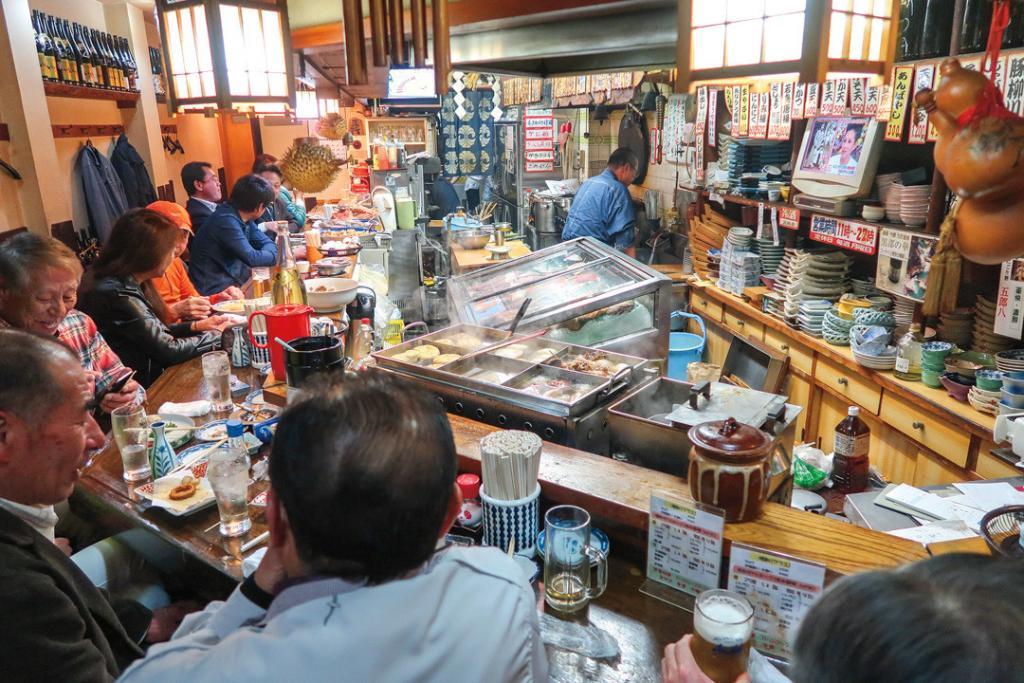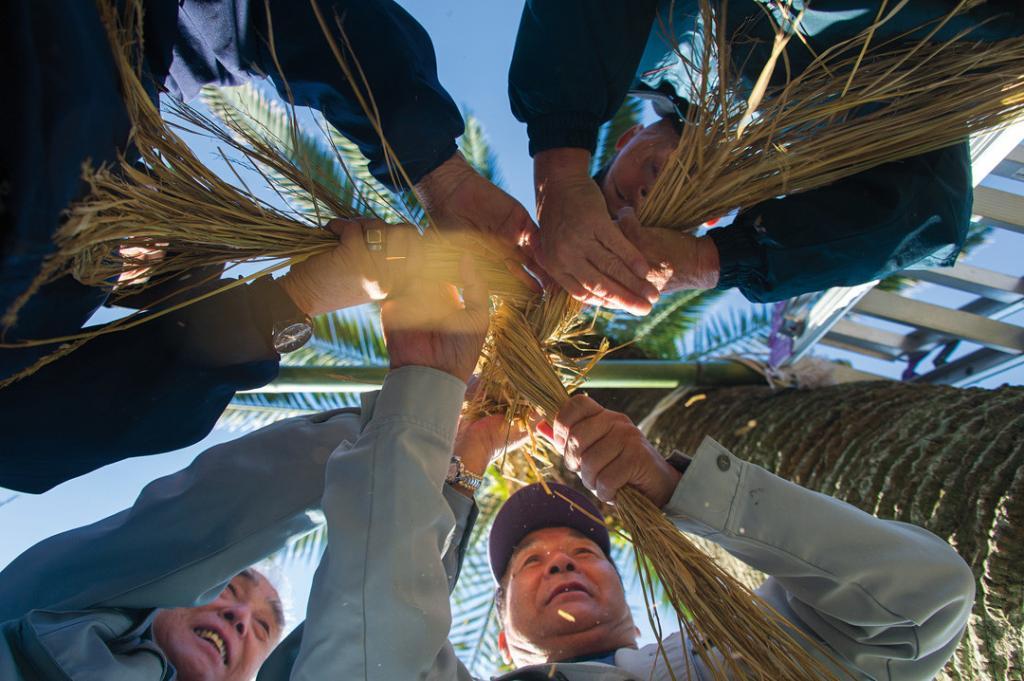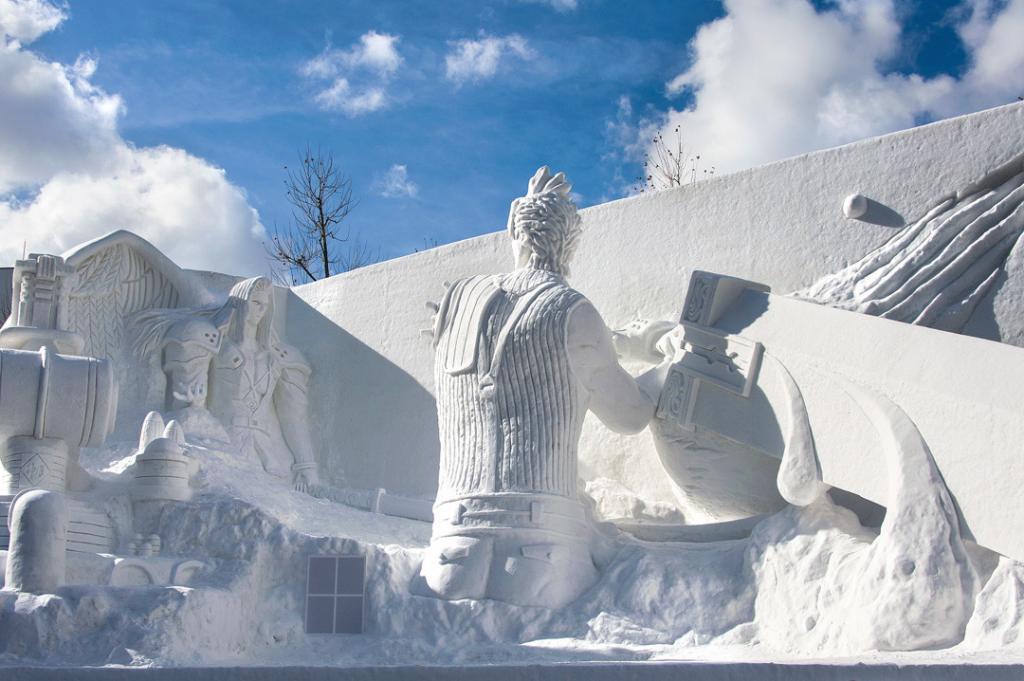Hemmed in by verdant mountain slopes shimmered a pond. Black- and cream-colored koi swam about lazily, rushing forward only when somebody threw them some fish feed. My attention was drawn to the elongated patch of grass with a tiny shrine in the center dedicated to Onokoro, Japan’s first island created by the gods. The story goes that this landmass appeared when the gods Izanagi and Izanumi placed a magic spear into the waters of the sea; when they lifted it out, drops from the spear formed Onokoro. After then building a great palace that centered around a heavenly pillar, the pair walked in opposite directions around the pillar, and when they met each other again, they wed. The remaining islands were the result of their union.
Among Japan’s plethora of myths and legends, a number are related to the country’s founding in what is now the town of Takachiho. Here the gods descended to earth, and Amaterasu hid in a cave near the present site of the Amano Iwato Shrine, causing darkness and disaster on Earth. Eight million of her children (deities) convened at the nearby Amanoyasugawara, luring Amaterasu from her hiding place with a trick, after which light and peace returned. Amaterasu is better known as the Sun Goddess, one of the main deities in Shinto, the prevailing religion in Japan. The emperors of Japan are considered to be her direct descendants.

Next to the pond, we gazed down the spectacular lava cliffs of the Takachiho Gorge. From lush vegetation sprang a 55-foot-high waterfall that plunged into the turquoise Gokase River. Takachiho breathed history and serenity.
We traveled through centuries of history on Kyushu, the southernmost of Japan’s four main islands, the others being Honshu, Hokkaido, and Shikoku. The Mongol invasions were repelled in the 13th century, and 300 years later Portugal brought visitors of a different sort: the first Jesuit missionaries and traders. Churches dotting the nearby Amakusa Islands are testimony to those days. During Japan’s 2 centuries of isolation, the Dutch were the only Westerners allowed to trade with the country from an enclave in what is currently Nagasaki. This is also the second city that was destroyed by an atomic bomb during WWII following Hiroshima, after which Japan surrendered on August 14, 1945. I was deeply touched by the empty yet solemn space of Ground Zero at Peace Park, which over the years has been expanded with shrines, statues, and monuments that pay tribute to the lives lost.


In Kagoshima, we wandered in and around a typical Edo Period garden with ponds, streams, bamboo, and manicured trees. It houses the Shuseikan Museum that details how Japan was catapulted into industrialization in the 19th century. The nearby Sakurajima Volcano belched, sprinkling the city with a thin layer of soft, gray ash. Floods, tsunamis, hurricanes, earthquakes, and volcanic eruptions regularly devastate homes and livelihoods—yet, people have continued to live here. It is easy to see why: there is so much to fall in love with and enjoy. Thanks to all the subterranean activity, the country is dotted with onsens, and we regularly soaked our travel-weary bodies in the scalding-hot, mineral-rich waters. We were also able to fill our water tank from the many natural fountainheads. Narrow roads hugging mountain slopes covered in forests—many of them clusters of Japanese cedar for logging—took us to the massive caldera of the active Mount Aso volcano. With its flat plains enclosed by crags, this is arguably one of Kyushu’s most scenic regions.

Just north of Aso lies Beppu, famous for its jigoku (literally means hell), steaming red mud pools, cobalt blue ponds, and spouting geysers. With our feet in a hot foot bath, we savored jigoku mushi cuisine, sweet bread and eggs steamed in the ponds. Away from the crowds, we found peace and quiet in the old Kannawa neighborhood; within its winding alleys we were invited to a matinee. After taking off our shoes, we sat in a traditional home made of wood with shōji, sliding doors of wooden frames with translucent paper. The 2-hour narration of a story, of which we understood nothing, alternated with music played on a bamboo flute—its drawn-out sounds carried us back to Japan’s days of samurais and geishas. Kyushu captivated us with its charm, laid-back atmosphere, and the openness of its people.


If you are a museum or ancient temple buff and enjoy nightlife, you get the best and most varied selection in and around the main cities on Honshu: Tokyo, Nagoya (check out Toyota’s excellent Automobile Museum), Osaka, and of course, Kyoto, Japan’s previous centuries-long capital and cultural center. No matter how worthwhile the cities’ tourist attractions, our focus was elsewhere. We headed to Japan’s northernmost island of Hokkaido.
By then, winter had set in. With snow several feet deep and averages of 25°F during the day and 5°F at night, Hokkaido is for the brave. Farmers and fishermen had swapped their plows and fishing boats for snow-plowing machines that were on the road 24/7. Our goal was the famous snow festival in Sapporo, held for the 68th time. Locals contributed with dozens of snow sculptures, international artists competed for the most remarkable creation, and the Japanese military brought in heavy machinery and created a life-size Arc de Triomphe. The adjacent town of Otaru celebrated winter with the Snow Light Path Festival, and Asahikawa’s Winter Festival included brilliantly carved ice sculptures. The Japanese know how to occupy themselves during the long, dark, and cold winter months. We stumbled upon a dog-sled race in Wakkanai and a village competition of pulling tree trunks. If the outdoor activities don’t entice you, there are breweries and distilleries to visit throughout the island. Many factories of beer, whisky, and sake include a museum and offer an opportunity to sample the best they have.


During the late 19th century, Hokkaido became the last island to be incorporated into the Empire of Japan. It had been inhabited by Northern European peoples of whom only the Ainu remain. Japan colonized the island using prisoners who were set to work to fell the woods, build roads, and construct buildings. The infamous Abashiri Prison has been transformed into an informative, comprehensive museum. We took all morning to see where and how prisoners lived, bathed, and ate. Work conditions were primitive, but inmates were self-sufficient in growing their own food, producing their own miso and sake. While the majority of Japanese travelers come to Hokkaido to ski on the famous slopes of Niseko (used in the 1972 Winter Olympic Games), we headed for the remote eastern part of the island. The minor roads inland were closed until May due to snow, but the mountains must be stunning to hike in summer and early autumn. We followed the Sea of Okhotsk with ice drifting along the shore and spotted hundreds of deer and dozens of foxes—their reddish-brown fur was easy to see on the blanket of white snow—as well as elegant Japanese cranes, a symbol of happiness and long life.


From the far north we drove to the south, and from winter into summer. Shikoku—the most remote of the four islands—offered cool mountain air in Iya Valley and a breeze along the coast characterized by rocky and sandy bays. While Japan’s beaches won’t make any world top 10 lists, they are beautiful and many are blissfully empty, even in July and August. At free camps, offering views of beautiful sunrises over transparent blue waters, we absorbed nature’s splendor, emptying our minds of the intensive sightseeing we had done. No matter how long we stay in a country, there is always more to see and experience. Our 9 months in this fascinating place was not enough time to do everything justice. Whether it is following Basho’s pilgrimage to Dewa Sanzan (the holy trio mountains of Tōhoku), admiring Totorri’s sand sculptures, or exploring haikyo (abandoned places) in Kansai, there are plenty of reasons to return. One day, we will.

TRAVEL TIPS
To rent a car or campervan, bring your international driver’s permit and credit card.
Simply put, there are two ways to drive around Japan. Fast and expensive, using the double-lane toll roads called expressways, or slow and free, using the regular highways that may be one or two lanes, plus the narrow country roads. If you have little time, I suggest using the expressways to get around major cities (especially between the high-density areas of Hiroshima and Tokyo), and enjoy meandering the minor roads in the countryside.

Convenience stores are all over the place. Stop here for foods on the go such as onigiris and bentos and affordable, fresh coffee. You can get WiFi at Lawson and 7-Eleven stores, and we withdrew money at 7-Eleven ATMs. They are also the place to drop your garbage (in small amounts) as Japan has hardly any public bins.
Michi no Ekis are popular road stations (michi-no-eki.jp/stations/english) where travelers can spend the night in the parking lot. They have public toilets, a tourist information center/counter, and oftentimes a farmer’s market.
Don’t expect English to be spoken—bring a dictionary and install Google Translate on your smartphone.
Author: Karin-Marjke Vis
Photography: Coen Wubbels

This article first appeared in the 2018 Spring issues Overland Journal.





